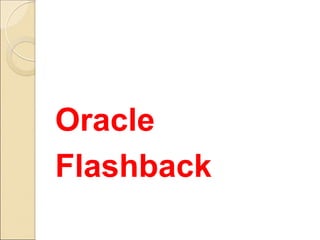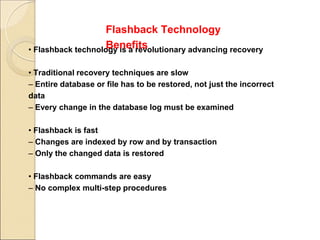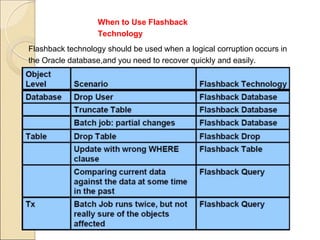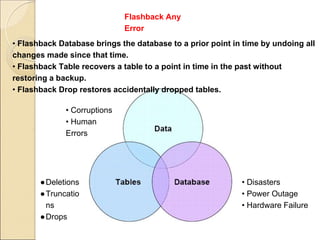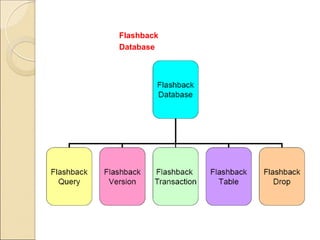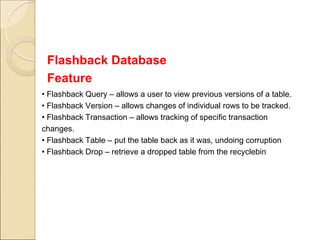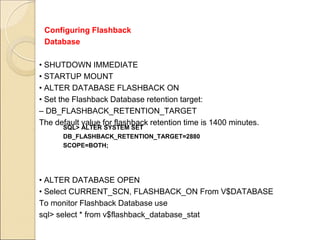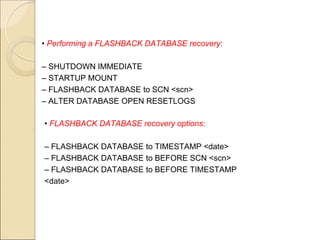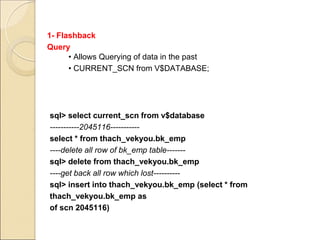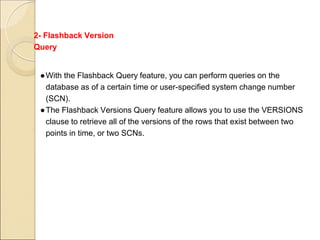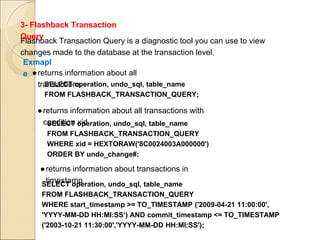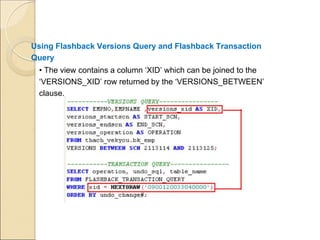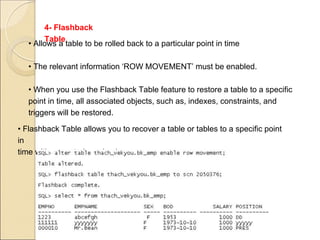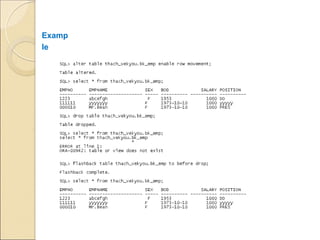Oracle flashback
- 2. âĒ Flashback technology is a revolutionary advancing recovery âĒ Traditional recovery techniques are slow â Entire database or file has to be restored, not just the incorrect data â Every change in the database log must be examined âĒ Flashback is fast â Changes are indexed by row and by transaction â Only the changed data is restored âĒ Flashback commands are easy â No complex multi-step procedures Flashback Technology Benefits
- 3. When to Use Flashback Technology Flashback technology should be used when a logical corruption occurs in the Oracle database,and you need to recover quickly and easily.
- 4. âĒ Corruptions âĒ Human Errors âDeletions âTruncatio ns âDrops âĒ Disasters âĒ Power Outage âĒ Hardware Failure âĒ Flashback Database brings the database to a prior point in time by undoing all changes made since that time. âĒ Flashback Table recovers a table to a point in time in the past without restoring a backup. âĒ Flashback Drop restores accidentally dropped tables. Flashback Any Error
- 6. âĒ Flashback Query â allows a user to view previous versions of a table. âĒ Flashback Version â allows changes of individual rows to be tracked. âĒ Flashback Transaction â allows tracking of specific transaction changes. âĒ Flashback Table â put the table back as it was, undoing corruption âĒ Flashback Drop â retrieve a dropped table from the recyclebin Flashback Database Feature
- 7. âĒ SHUTDOWN IMMEDIATE âĒ STARTUP MOUNT âĒ ALTER DATABASE FLASHBACK ON âĒ Set the Flashback Database retention target: â DB_FLASHBACK_RETENTION_TARGET The default value for flashback retention time is 1400 minutes. âĒ ALTER DATABASE OPEN âĒ Select CURRENT_SCN, FLASHBACK_ON From V$DATABASE To monitor Flashback Database use sql> select * from v$flashback_database_stat Configuring Flashback Database SQL> ALTER SYSTEM SET DB_FLASHBACK_RETENTION_TARGET=2880 SCOPE=BOTH;
- 8. âĒ Performing a FLASHBACK DATABASE recovery: â SHUTDOWN IMMEDIATE â STARTUP MOUNT â FLASHBACK DATABASE to SCN <scn> â ALTER DATABASE OPEN RESETLOGS âĒ FLASHBACK DATABASE recovery options: â FLASHBACK DATABASE to TIMESTAMP <date> â FLASHBACK DATABASE to BEFORE SCN <scn> â FLASHBACK DATABASE to BEFORE TIMESTAMP <date>
- 9. 1- Flashback Query sql> select current_scn from v$database -----------2045116----------- select * from thach_vekyou.bk_emp ----delete all row of bk_emp table------- sql> delete from thach_vekyou.bk_emp ----get back all row which lost---------- sql> insert into thach_vekyou.bk_emp (select * from thach_vekyou.bk_emp as of scn 2045116) âĒ Allows Querying of data in the past âĒ CURRENT_SCN from V$DATABASE;
- 10. 2- Flashback Version Query âWith the Flashback Query feature, you can perform queries on the database as of a certain time or user-specified system change number (SCN). âThe Flashback Versions Query feature allows you to use the VERSIONS clause to retrieve all of the versions of the rows that exist between two points in time, or two SCNs.
- 12. Flashback Transaction Query is a diagnostic tool you can use to view changes made to the database at the transaction level. 3- Flashback Transaction Query SELECT operation, undo_sql, table_name FROM FLASHBACK_TRANSACTION_QUERY; âreturns information about all transactions Exmapl e SELECT operation, undo_sql, table_name FROM FLASHBACK_TRANSACTION_QUERY WHERE xid = HEXTORAW('8C0024003A000000') ORDER BY undo_change#; âreturns information about all transactions with condition xid SELECT operation, undo_sql, table_name FROM FLASHBACK_TRANSACTION_QUERY WHERE start_timestamp >= TO_TIMESTAMP ('2009-04-21 11:00:00', 'YYYY-MM-DD HH:MI:SSâ) AND commit_timestamp <= TO_TIMESTAMP ('2003-10-21 11:30:00','YYYY-MM-DD HH:MI:SS'); âreturns information about transactions in timestamp
- 13. Using Flashback Versions Query and Flashback Transaction Query âĒ The view contains a column âXIDâ which can be joined to the âVERSIONS_XIDâ row returned by the âVERSIONS_BETWEENâ clause.
- 14. 4- Flashback Table âĒ Allows a table to be rolled back to a particular point in time âĒ The relevant information âROW MOVEMENTâ must be enabled. âĒ When you use the Flashback Table feature to restore a table to a specific point in time, all associated objects, such as, indexes, constraints, and triggers will be restored. âĒ Flashback Table allows you to recover a table or tables to a specific point in time without restoring a backup.
- 15. 5- Flashback Drop âĒ Acts as a âRECYCLEBINâ allowing dropped tables to be retrieved âĒ Flashback Drop is a variation of Flashback table as it handles rolling back a dropped table. âĒ Dropped tables are âRENAMEDâ in the âRECYCLEBINâ and can be retrieved using the âFLASHBACK DROPâ command. âĒ Tables must be in Locally managed tablespaces âĒ Tables must not be in the SYSTEM tablespace âĒ The relevant information âROW MOVEMENTâ must be enabled.
- 16. Examp le
- 17. The End Author : Thach Vekyou http://top10town.com

